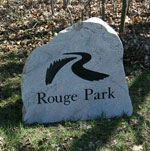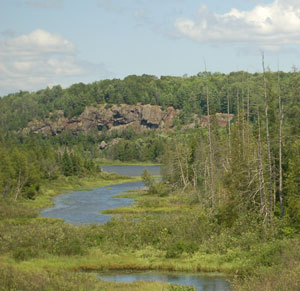
Toronto's Rouge Park is thirteen times the size of New York's Central Park and considered the largest nature park located within a metropolitan core in North America..

FRONT PAGE
Site Search
About us | Quiénes somos |
A propos de nous | Über uns |
Mayor Monitor
Directories
Events
Debate

Toronto's Rouge Park
North America's greenest cities
Europe's greenest cities
Bi-national Öresund Region
Green cities initiative
Europe's cities and suburbs
Green mayors
Urban ecological footprint
Cities' green policies
US cities to go green
Cities and biodiversity
Mexico City's Green Plan

City Mayors reports news from towns and cities around the world. Worldwide | Elections | North America | Latin America | Europe | Asia | Africa |

City Mayors ranks the world’s largest, best as well as richest cities and urban areas. It also ranks the cities in individual countries, and provides a list of the capital cities of some 200 sovereign countries. More

City Mayors profiles city leaders from around the world. More

City Mayors describes the history, architecture and politics of the greatest city halls in the world. More

Mayors from The Americas, Europe. Asia, Australia and Africa compete for the World Mayor Award. More
Use Mayor Monitor to rate the performance of mayors from across the world More

In your opinion: Praise Criticise. Write

City Mayors reports political events, analyses the issues and depicts the main players. More

City Mayors describes and explains the structures and workings of local government in Europe, The Americas, Asia, Australia and Africa. More

City Mayors deals with economic and investment issues affecting towns and cities. More

City Mayors describes and explains financial issues affecting local government. More

City Mayors reports urban environmental developments and examines the challenges faced by cities worldwide. More

City Mayors reports on and discusses urban development issues in developed and developing countries. More

City Mayors reports on developments in urban society and behaviour and reviews relevant research. More

City Mayors invites readers to write about the people in their cities. More
City Mayors examines city brands and marketing. More

City Mayors lists and features urban events, conferences and conventions aimed at urban decision makers and those with an interest in cities worldwide. More

City Mayors deals with urban transport issues in developed and developing countries and features the world’s greatest metro systems. More

City Mayors examines education issues and policies affecting children and adults in urban areas. More

City Mayors investigates health issues affecting urban areas with an emphasis on health in cities in developing countries. More

City Mayors reports on how business developments impact on cities and examines cooperation between cities and the private sector. More

City Mayors examines the contributions history and culture make to urban society and environment. More

City Mayors examines the importance of urban tourism to city economies. More

City Mayors questions those who govern the world’s cities and talks to men and women who contribute to urban society and environment. More

City Mayors profiles national and international organisations representing cities as well as those dealing with urban issues. More

City Mayors reports on major national and international sporting events and their impact on cities. More

City Mayors lists cities and city organisations, profiles individual mayors and provides information on hundreds of urban events. More
Toronto’s Rouge Park to become
Canada’s first urban national park
By Kevin Bourne, Canada Editor
6 July 2011: With the election of the federal Conservatives the outlook on the urban agenda in Canada was mixed. But the recent Throne speech provided some optimism for Canadian urbanism outlining the creation of Canada’s first urban national park in the Greater Toronto Area, although there were no funds promised in the budget.
Rouge Park, designated a provincial park by the Province of Ontario in 1995, is slated to take its place along the other 42 National Parks and National Park Reserves in Canada. Although there are more than 12 government organizations and one non-profit owning and managing the land, including the Toronto Region Conservation Authority, the cities of Markham and Toronto, and the Province, it is expected to be taken over by Parks Canada within two years once a national park plan is in place.
The Throne speech read, “In this, the 100th anniversary year of our national parks system, our government will create significant new protected areas. It will work with provincial, regional, municipal, aboriginal and community stakeholders toward establishing an urban national park in the Rouge Valley of eastern Toronto.”
As the federal Conservatives increase their focus on the Greater Toronto Area, some may either see this as a celebration of their recent success in the region or a means of gaining further support.
Despite the lack of funding Markham Deputy Mayor Jack Heath is confident the project will move forward. “I would have liked to see funding in the federal budget, as it gives more than anything else the intention of the federal government. But it doesn’t stymie us or set us back.”
Toronto City Councillor Glenn De Baeremaeker also weighed in on the announcement. “It truly is, by a historic fluke, almost an untouched wilderness area, a small wilderness area on the edge of the city of Toronto. It has taken a couple of decades, but to see this in writing, in a government document, in a throne speech telling the nation what they are going to do is fabulous.” Councillor De Baeremaeker had been fighting for the designation for 25 years.
Alan Wells, chair of the Rouge Park Alliance said, “Parks Canada brings resources that we don’t have, like park wardens to stop poachers and to keep the trails safe. The trails need a lot of maintenance, so it’s bigger than the City of Toronto can manage.”
 Located within the boundaries of Toronto, Pickering, Markham and Stouffville, Rouge Park will be Canada’s first national park to be located within a municipality. Covering an area thirteen times the size of New York’s Central Park, it is also considered the largest nature park located within a metropolitan core in North America. The Rouge’s urban surroundings will give it a unique feel from all other National Parks in Canada. The Rouge will be the fifth smallest of all National Parks and National Park Reserves. It will also be accessible by public transit as Toronto Transit Commission buses and GO Transit, the provincial bus and rail commuter transit system, currently serve the park. Unfortunately its urban surroundings also pose a significant threat especially through residential development in Toronto and Markham.
Located within the boundaries of Toronto, Pickering, Markham and Stouffville, Rouge Park will be Canada’s first national park to be located within a municipality. Covering an area thirteen times the size of New York’s Central Park, it is also considered the largest nature park located within a metropolitan core in North America. The Rouge’s urban surroundings will give it a unique feel from all other National Parks in Canada. The Rouge will be the fifth smallest of all National Parks and National Park Reserves. It will also be accessible by public transit as Toronto Transit Commission buses and GO Transit, the provincial bus and rail commuter transit system, currently serve the park. Unfortunately its urban surroundings also pose a significant threat especially through residential development in Toronto and Markham.
As Toronto’s biggest wetland, Rouge Park has the most bio-diverse ecosystem in the region, home to 762 plant species, including six nationally rare species and 92 regionally rare species. It is also home to over 300 bird, fish, mammal and reptile species, many of which are locally, regionally and nationally rare. It has six major waterways running through it which run through four municipalities, including the Rouge River, Toronto’s most healthy river.
According to the Rouge Park Alliance, “The Rouge Park is Canada’s premier urban wilderness park protecting two National Historic Sites, and the only working farms in Toronto.”
From the 19th century to the 1950s the Rouge served as an urban retreat, home to many resorts and cottages, and it currently has three golf courses in the vicinity, and 16 kilometres of trails and campgrounds running through it. The hope is that with the National Park designation it will become North America's premier urban wilderness.
The park also has a strong agricultural heritage, having many farmers as tenants. The park’s main objective is the preservation of “near-urban agriculture” although the alliance recently made a confidential decision to end leases for over 700 acres of farmland. Mr. Wells has said in the past he would like to see the Federal Government add 5,000 acres in farmland to the park which was expropriated for the failed Pickering Airport project. As discussions on the National Park designation heated up in late 2010, farmers, whose lands were expropriated 40 years ago for the creation of the Pickering Airport, expressed concern over the proposal.
Human history in the Rouge, which was once covered by a glacier, goes back over 10,000 years to Palaeolithic nomadic hunters, Iroquoian women farmers and early European explorers, and with the National Park designation the natural environment and human activity will be a part of the area for many years to come.

